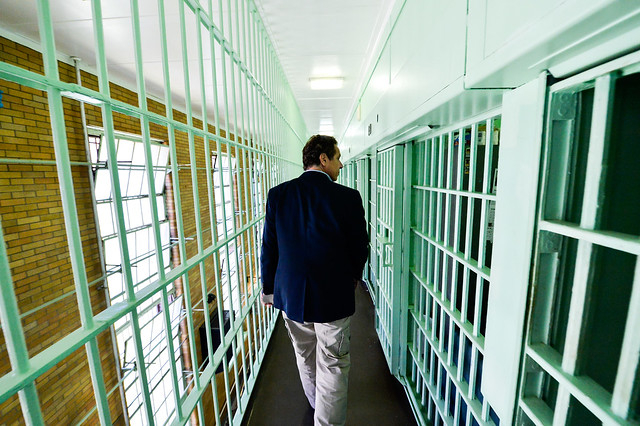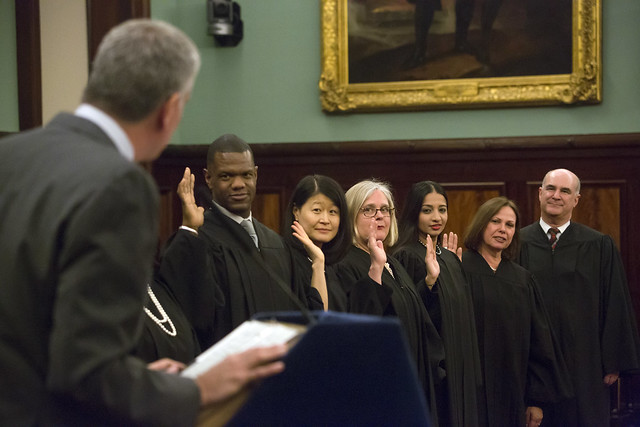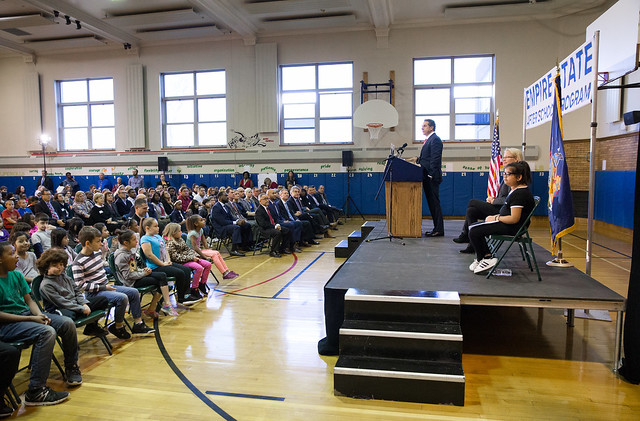Lives on the Line: Legislature Must Reform Solitary Confinement Before Session's End

(photo: Governor's Office)
Thousands of people are subjected to long-term solitary confinement in New York. The United Nations calls it torture. New York’s jails and prisons call it business as usual.
Our state’s laws permit 23-hour confinement for months and even years at a time in jails and prisons across the state. This despite the fact that long-term solitary confinement creates severe and irreparable mental and physical trauma. Its effects can be deadly. The death this month of Layleen Polanco in a solitary cell at Rikers is just the latest example.
In 2015, the state and the New York Civil Liberties Union reached a settlement that required critical changes to the use of solitary confinement in state prisons. Although the state has made important efforts to reform solitary confinement for people in prisons, we need the legislature to pass more comprehensive changes to ensure that individuals held in both prisons and jails are no longer subjected to solitary confinement in state prisons and local jails that lasts longer than 15 consecutive days.
People in solitary confinement are seven times more likely to hurt or kill themselves. We cannot afford to wait on reform. Thousands of people are in danger and there is a bill in the state legislature that could help them.
The Humane Alternatives to Long-Term Solitary Confinement (HALT) Act would make several important changes to the way our state currently uses solitary. First, it would prohibit long-term solitary confinement by limiting the time spent in confinement to no more than 15 consecutive days or 20 days total in any 60-day period.
The HALT Act would ban the solitary confinement of especially vulnerable people, including those 21 years or younger, 55 years or older, and people with certain disabilities. The government would also be barred from locking up in solitary anyone who is pregnant or in post-partum recovery or anyone who is a new mother or caring for a child while incarcerated.
Critically, the legislation would prohibit solitary for all but a small set of serious offenses. And HALT would provide rehabilitative programming that would help keep jails and prisons safer for everyone, including staff. To that end, it mandates that all people in solitary receive at least six hours of out-of-cell rehabilitative programming, plus one hour of out-of-cell recreation per day.
In settling the NYCLU’s lawsuit, Governor Cuomo has acknowledged that the state needs to reduce its reliance on solitary confinement. The settlement was critical to reducing the state’s reliance on isolated confinement. But we need his leadership to push for more comprehensive reform that protects the health of everyone in our jails and prisons by ending prolonged solitary confinement.
No one should be subject to torture.
Speaker Carl Heastie and Majority Leader Andrea Stewart-Cousins must act now and bring HALT to a vote. In 2018, New Yorkers voted to end the gridlock in Albany that kept progressive legislation like HALT from passing. By voting for this bill, lawmakers will help show that this legislative session is different and that the status quo of Albany inaction is over.
***
Donna Lieberman is the Executive Director of the New York Civil Liberties Union. On Twitter @JustAskDonna & @NYCLU.
***
Have an op-ed idea or submission for Gotham Gazette? Email This email address is being protected from spambots. You need JavaScript enabled to view it.
Our Judicial Elections are Broken, But They’re No Joke

(photo: Ed Reed/Mayoral Photography Office)
On June 25, Brooklyn Democrats will hold a primary to select the Democratic candidates for judges of the Civil Court and judge of the Surrogate Court.
New York has a convoluted system for selecting judges. Some are appointed by the Governor. Criminal and Family Court judges in New York City are appointed by the Mayor. Candidates for Supreme Court are nominated at a judicial nominating convention, while candidates for Civil Court and Surrogate Court are elected through a traditional primary election.
Further complicating matters, candidates for Surrogate Court run county-wide as do some candidates for Civil Court. However, some candidates for Civil Court are elected by a subset of voters in what is called a “municipal district.”
This is a dysfunctional system. There is no justification for some judges to be appointed and some elected. There is no justification for some candidates to be nominated at a judicial convention and others to run in a primary. There is no justification for some judges to run county-wide and others to get elected by a subset of voters.
This convoluted system undermines the goal of a merit-based selection of judges, is almost entirely dominated by Democratic Party leaders, and lacks controls to prevent an unqualified candidate from becoming a judge.
Take, for example, this year’s primary for judge of the Surrogate Court. Judge Margarita Lopez Torres is running for reelection. She is an excellent judge who famously refused to give a patronage job at the direction of the then-Brooklyn Democratic Party boss, Clarence Norman, who would go on to serve a prison sentence for corruption.
As a result of her “defiance,” party leaders, who controlled the judicial nominating convention, blocked her from seeking election to the New York Supreme Court. She became the plaintiff in a lawsuit claiming the way New York elects Supreme Court judges was unconstitutional, which would eventually lose at the U.S. Supreme Court.
Her 14-year term now up, she faces a bitter primary from two opponents in her bid for reelection. Meredith Jones, while found qualified to be a judge of the Surrogate Court, is running at the behest of allies of the disgraced party boss whom Judge Lopez Torres spurned close to two decades ago and who are using the primary to seek retribution. The other primary opponent, Judge Elena Baron, is a sitting Civil Court judge elected only two years ago. After declining to appear before the New York City Bar Association for what she said are ethical concerns with the panel because the attorneys appear before judges that they rate, she was deemed "not approved." Her campaign is being run by a notorious political consultant who uses judicial elections as an opportunity to make money while “sticking it to the machine.” (I have endorsed Judge Lopez Torres in my capacity as an elected District Leader for Brooklyn's 44th Assembly District.*)
There are only two Surrogate Court judges in Brooklyn. They will decide thousands of sensitive cases dealing with complicated end-of-life issues. If Judge Baron were elected, 50% of cases would be heard a judge who should not be presiding over them. This does not “stick it to the machine.” It sticks it to the grieving Brooklynites going through the Surrogate Court to carry out the last wishes of their departed loved ones.
Likewise, the primary for Civil Court judge from the 6th Municipal District (where I live) features a candidate, Tehilah Berman, found not approved by both the Brooklyn Democratic Party screening panel and the New York City Bar Association.
Our legal system depends upon public confidence in the quality and integrity of the judges hearing our cases. Judge Berman's election to the Civil Court would be a mistake given her lack of relevant experience, including next to no litigation experience. When I recently confronted her about her lack of qualifications, her campaign manager sent me a message on Facebook threatening, “next time you will deal with me or one of my team members.”
It is time for New York to abolish judicial elections altogether in favor of a unitary merit-based appointive system. While appointment of judges is not without the potential for political influence, it would exponentially reduce the vice grip that the Democratic Party machine has on election of judges to the Supreme Court and significantly reduce the likelihood of an unqualified candidate becoming a judge of any court.
Likewise, there are highly-qualified attorneys who don’t seek judgeships because they refuse to play in the swamp of the current system, but would absolutely seek appointment in a merit-based system.
Finally, mechanisms can be implemented to reduce the influence of politics in the selection of judges. For example, under the current mayor, there is an open application process and the office responsible for political appointments plays no role in the evaluation and recommendation of applicants.
That said, the primary election is next week away and we have to vote in the system we currently have.
So, I ask all Brooklynites, before you vote, please do your research. Information about judicial candidates is often scant. But this year, many of the judges have Facebook pages and campaign websites. Visit them. New Kings Democrats have put out an excellent, much welcome and needed judicial election guide. Read it.
When unqualified judges get elected, two people win -- the unqualified judge and their campaign consultant. Hundreds of thousands of Brooklynites lose. These are real people, with real legal problems, who deserve to have their cases decided by real judges.
***
Doug Schneider is the Democratic District Leader for the 44th Assembly District covering parts of Park Slope, Windsor Terrace, Kensington, Boro Park, Midwood, and Ditmas. *He has endorsed candidates in three judicial races, two mentioned above (Judge Lopez Torres and Caroline Cohen for Civil Court from the 6th Judicial District, as well as D. Bernadette Neckles for Civil Court countywide). Although unofficial, for Supreme Court he has one of 42 votes in nominating Democratic candidates, a power he is advocating to end. On Twitter @DougSchneiderBK.
***
Have an op-ed idea or submission for Gotham Gazette? Email This email address is being protected from spambots. You need JavaScript enabled to view it.
Note: this article has been corrected to remove characterization of Baron's recommendation from the NYC Bar Association as "unqualified." The recommendation was "not approved."
Smells Like Teen Surveillance

(photo: Philip Kamrass/Office of Governor Andrew M. Cuomo)
Picture a student sprinting to math class, late for a test after sleeping through the alarm. Hair disheveled, backpack open, their heart is racing. But in an instant this quintessential scene morphs into something far more dangerous as the student is faced with armed police officers, aiming their guns, demanding the student lie down on the ground.
This is the grim prospect for the students of Lockport, New York, whose school district is the latest to stumble headlong into the national surveillance debate.
In Lockport, students will no longer just be graded on their homework and exams, they’ll receive a grade from the school’s state-of-the-art surveillance boondoggle: facial recognition. Let’s be clear, facial recognition technology has no place in schools. It is expensive, invasive, and more than a little bit creepy. The newest versions claim they predict behavior, but that “suspected school shooter” is actually just an anxious kid who’s running late for a test.
Even worse, many facial recognition systems will label students as a “threat” because of their race.
The facts are clear: facial recognition is biased. The technology can be eerily accurate, but error rates are much higher for women and people of color. When one commercial product looked at members of Congress, it largely gave white representatives a pass, but falsely claimed that half a dozen of members of the Congressional Black Caucus were criminals.
Bias would be reason enough to scrap this Orwellian misadventure, but things get worse. Facial recognition fails more often for minors and people under stress. That’s right, they’re putting a racist surveillance technology that’s undermined by moody teenagers…in a high school.
And the problems don’t end there. Not only is facial recognition biased and broken, it is expensive. Lockport doled out nearly $4 million for their eight-school system. Millions that could support students, being used to surveil them instead. But the cost is more than dollars and cents; this system comes at a steep cost to student privacy. The system captures the biometric data of every person setting foot in the school, building a database that could be harnessed by law enforcement or even ICE.
Alarmingly, Lockport’s impact could extend far beyond the eight-square-mile town. Cities and states look to each other for policy innovation, copying each other on things related to “security” all the time. So long as state and federal officials allow money to be squandered this way, there will be a financial incentive for other school districts to follow Lockport’s dubious lead.
State officials must do more. In recent days, Governor Cuomo belatedly noted his “concerns” about this discriminatory surveillance net, but his comments are too little, too late. The half-hearted condemnation is particularly unconvincing in light of his past facial recognition advocacy.
Just last year, the governor rushed the roll-out of a disastrous facial recognition project on the Robert F. Kennedy Bridge that failed to detect a single face. It’s time for the governor to face the music on surveillance and call for a state-wide moratorium on facial recognition.
As a first step, we must prohibit facial recognition in schools -- it’s the very least we can do. That’s exactly what lawmakers might do in a few days when they should vote on a measure from Assemblymember Monica Wallace and State Senator Brian Kavanagh, banning biometric data collection in schools. The measure might be too late to help the students whose data was already recorded in Lockport, but we can make sure no other students have to give up their privacy and civil rights as the price of attending classes.
***
Cahn is the executive director of The Surveillance Technology Oversight Project, a New York-based civil rights and police accountability organization. On Twitter @cahnlawny. Blum is a rising 3L at NYU School of Law and a civil rights intern at The Surveillance Technology Oversight Project. On Twitter @JamesLBlum.
***
Have an op-ed idea or submission for Gotham Gazette? Email This email address is being protected from spambots. You need JavaScript enabled to view it.




